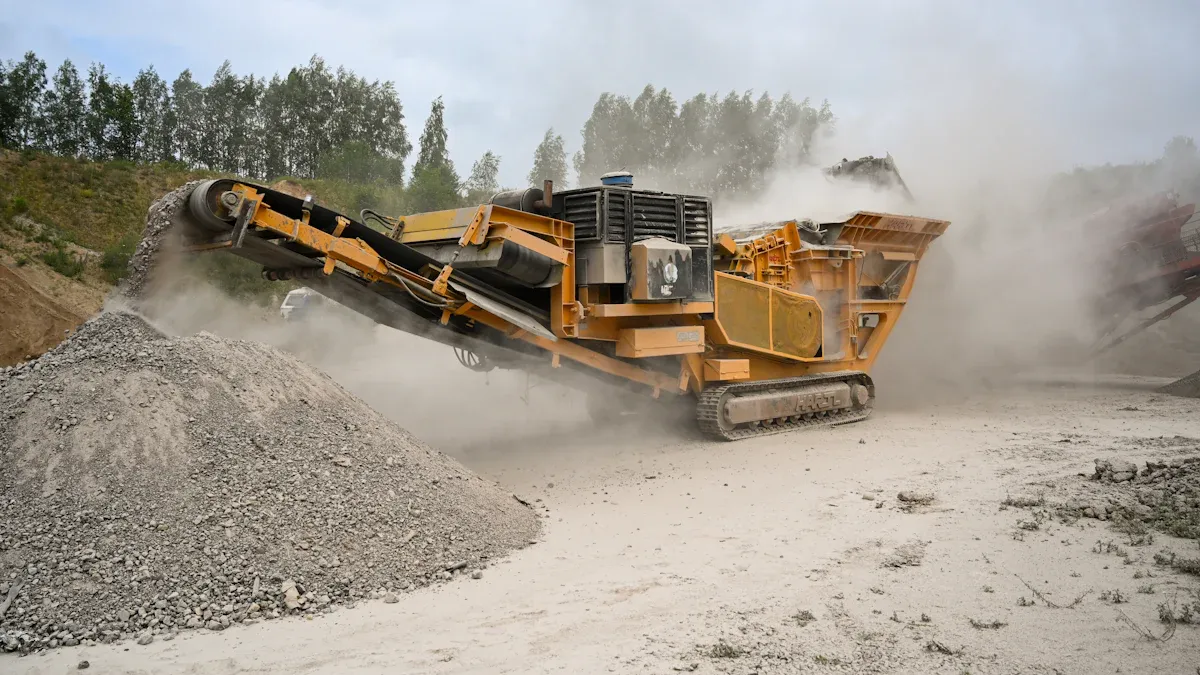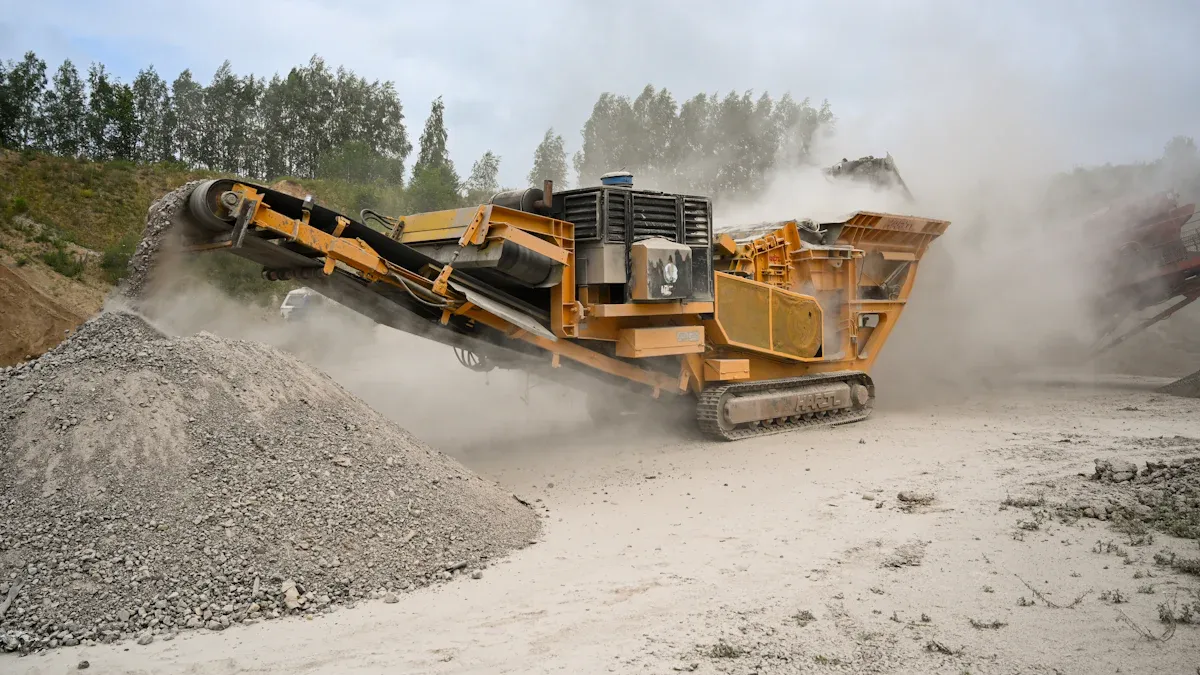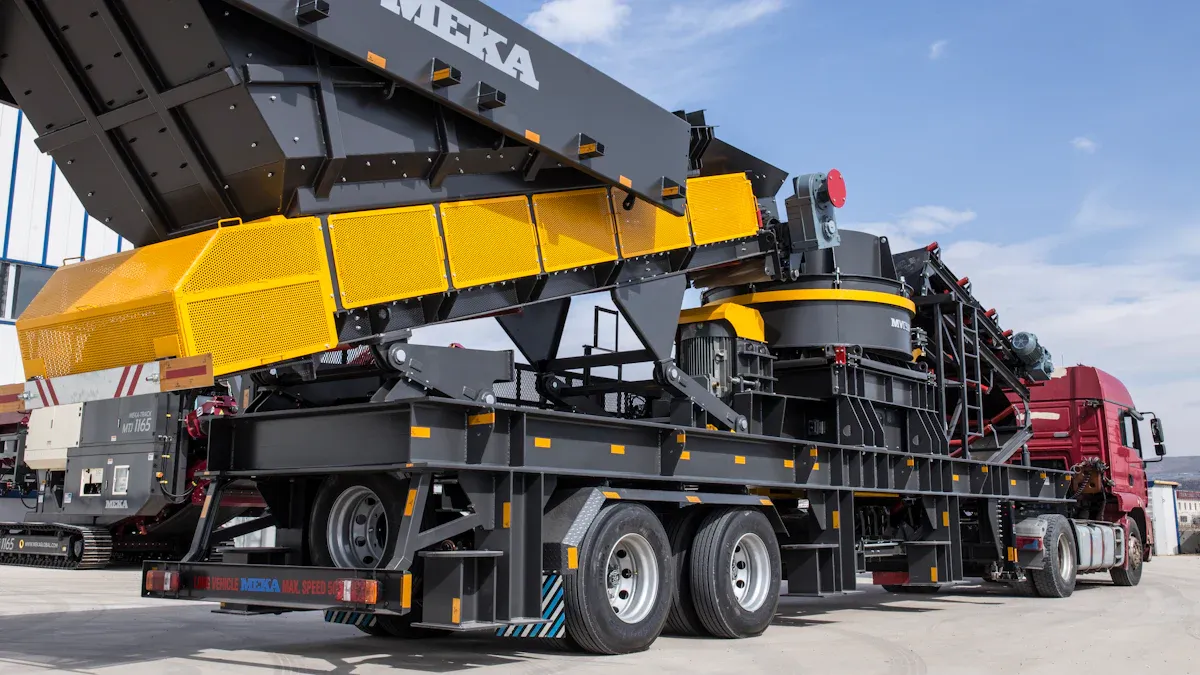
Manufacturers of jaw crusher plates ensure their products meet industry standards by prioritizing material quality, innovative designs, and rigorous testing. You benefit from their focus on high-grade materials that enhance durability and performance. By adhering to strict guidelines, they create reliable and efficient solutions tailored to your needs. This commitment to excellence ensures that the equipment performs consistently, even in demanding conditions. Their adaptability to new challenges guarantees that you receive cutting-edge products designed to meet modern requirements.
Industry standards play a critical role in ensuring the safety and reliability of jaw crusher plates. Manufacturers design modern plates to minimize risks during operation. Older designs often required workers to manually clear blockages or adjust components, leading to accidents. For example:
- The Mine Safety & Health Administration (MSHA) reported injuries caused by workers dislodging steel caught in primary jaw crushers.
- A maintenance worker was fatally injured while removing a toggle plate seat that moved unexpectedly.
By adhering to strict safety guidelines, manufacturers reduce these risks. You benefit from safer equipment that protects workers and minimizes downtime caused by accidents.
Standardized manufacturing methods ensure consistent quality in jaw crusher plates. High-quality plates last longer and perform better, reducing the need for frequent replacements. Without these standards, inferior plates could wear out quickly, leading to increased costs and inefficiencies. Consistency in production benefits you by providing reliable products that meet your expectations every time.
Industry standards also help manufacturers meet your expectations. You rely on jaw crusher plates to handle demanding tasks without failure. By following established guidelines, manufacturers deliver products that perform consistently under pressure. This reliability builds trust and ensures you can focus on your operations without worrying about equipment failure.

The material composition of jaw plates directly impacts their performance and durability. Manufacturers use high-grade steel and alloys to ensure the plates can withstand the demanding conditions of crushing operations. You benefit from materials specifically chosen for their strength and wear resistance. Common materials include:
- High Manganese Steel: This material offers exceptional wear resistance, making it ideal for handling hard and abrasive materials.
- Medium Manganese Steel: Known for its balance of toughness and workability, it is suitable for crushing concrete and quartz.
- Medium-Carbon-Low-Alloy Cast Steel: This material combines hardness and flexibility, making it a good choice for smaller crushers with lower impact requirements.
These materials ensure jaw plates can endure heavy loads and abrasive forces, providing you with reliable and long-lasting performance.
Abrasion resistance is a critical factor in the lifespan of jaw plates. Materials like manganese steel improve wear resistance over time through a process called work-hardening. This means the more you use the jaw plates, the tougher they become. Alloy steel, on the other hand, offers consistently high abrasion resistance, making it suitable for fine crushing applications.
The table below compares the performance of manganese steel and alloy steel jaw plates:
| Feature | Manganese Steel Jaw Plates | Alloy Steel Jaw Plates |
|---|---|---|
| Hardness | Medium (Work-hardening) | Higher Initial Hardness |
| Wear Resistance | Increases Over Time | Consistently High |
| Impact Resistance | High (Shock-absorption) | Lower (May Crack Under High Impact) |
| Abrasion Resistance | Good for coarse crushing | Better for fine crushing |
| Best For | Hard, abrasive rocks | Softer materials & fine crushing |
| Lifespan | Medium to Long (Depends on Work-hardening) | Long (If Used in Correct Application) |
| Cost | Lower initial cost | Higher initial cost |
By selecting the right material for your specific application, you can maximize the lifespan of your jaw plates and reduce operational costs.
To ensure quality and performance, jaw plate material must comply with international standards. These standards define the chemical composition and mechanical properties required for high-grade materials. Compliance guarantees that the jaw plates you use meet industry benchmarks for safety and reliability.
The table below highlights some of the key standards for jaw plate materials:
| Standard | Description |
|---|---|
| EURONORM 1.3401 | Specifies chemical composition and mechanical properties for high manganese steel plates. |
| DIN W1.3401 | Ensures quality and performance standards for manganese steel. |
| AFNOR X120Mn13 | Outlines requirements for high manganese steel plates. |
| ASTM A128 Gr B2 | Defines standards for manganese steel used in various applications. |
| ISO 21635:2018 | Details requirements for high manganese austenitic steel plates in LNG tanks and pressure vessels. |
When you choose jaw plates that adhere to these standards, you can trust their durability and performance. Certified materials also reduce the risk of unexpected failures, ensuring smooth and efficient operations.

The geometry of jaw plates plays a crucial role in improving crushing performance. Engineers focus on factors like the angle of nip, the toggle plate's angle, and the eccentricity of the shaft to enhance efficiency. For example, increasing the eccentricity allows the plates to crush materials more effectively, boosting productivity. Adjusting the toggle plate's angle also ensures better material flow and reduces blockages.
Performance metrics such as tons per hour (TPH) highlight the impact of optimized geometry. Larger crusher openings and smaller closed-side settings (CSS) improve throughput and ensure uniform material processing. This results in higher-quality output, which is essential for industries like mining and construction. By optimizing these design elements, you can achieve consistent and efficient crushing operations.
Advanced designs significantly improve the durability of jaw plates. Modern engineering incorporates features like reversible jaws and variable wear rates to extend the lifespan of the plates. For instance, new Optitooth jaw plates have demonstrated remarkable durability in real-world applications. They increased output from 200 to 250 TPH and improved wear rates by over 30%. In granite crushing, their lifespan rose from 20,000-30,000 tonnes to 50,000-55,000 tonnes.
These innovations reduce the frequency of replacements, saving you time and costs. Materials like high manganese steel and alloy steel further enh ance durability by resisting wear and absorbing impact. With these advancements, you can rely on jaw plates that perform consistently under demanding conditions.
The development of efficient jaw plates requires collaboration between engineers and industry experts. Engineers conduct structural analyses to prevent vibrations and fatigue cracks during operation. They also evaluate different plate profiles, such as flat surfaces and triangular shapes, to determine the most effective designs.
Indu stry experts provide insights into real-world challenges, ensuring the designs meet practical requirements. Together, they test prototypes under various conditions to refine the plates for optimal performance. This collaborative approach ensures you receive jaw plates that combine innovative engineering with practical functionality.
Testing ensures jaw plates meet the demands of crushing operations. Stress testing evaluates how well the plates handle heavy loads and high-pressure conditions. Engineers simulate extreme forces to identify weak points and improve the design. Abrasion testing measures the resistance of jaw plates to wear caused by friction and impact. This process involves exposing the plates to abrasive materials like sand or gravel to assess their durability.
You benefit from these tests because they ensure the jaw plates can withstand harsh environments without failing. For example, hig h manganese steel plates undergo rigorous abrasion testing to confirm their work-hardening properties. This guarantees that the plates become tougher with use, providing long-lasting performance.
Real-world simulations replicate the conditions jaw plates face during operation. Engineers use advanced software to model scenarios like crushing hard rocks or processing abrasive materials. These simulations help identify potential issues before the pla tes are manufactured.
Field tests complement these simulations by evaluating the plates in actual working environments. For instance, a mining site might test new jaw plates on granite to measure their performance. This combination of virtual and real-world testing ensures the plates meet your expectations for reliability and efficiency.
A recent study highlights the importance of such testing protocols. It used meta-analysis to evaluate the effectiveness of jaw plate testing by e xamining factors like anatomical differences and material variations. The findings revealed significant differences in performance based on these factors. This insight helps manufacturers refine their testing methods to produce better-quality jaw plates.
Certification ensures jaw plates meet industry standards for safety and performance. Regulatory bodies like ASTM and ISO define the requirements for materials and manufactu ring processes. Manufacturers must comply with these standards to guarantee their products are safe and reliable.
You can trust certified jaw plates because they undergo rigorous testing and quality checks. For example, plates made from high manganese steel must meet ASTM A128 standards for chemical composition and mechanical properties. This ensures the plates deliver consistent performance in demanding applications.
Regulatory compliance also benefits you by reducing the risk of equipment failure. Certified jaw plates are less likely to crack or wear out prematurely, saving you time and money on replacements. By choosing products that meet these standards, you ensure the safety and efficiency of your operations.
Manufacturers of jaw plates constantly adopt new technologies to improve their products. Automation plays a key role in modern manufacturing. Automated control systems allow precise shaping and finishing of jaw plates, ensuring consistent quality. Hybrid models are another innovation. These machines combine electric and hydraulic systems to reduce energy consumption. You benefit from these advancements through more efficient and eco-friendly solutions.
Technological improvements also focus on reducing emissions. Advanced filtration systems now minimize pollutants during production. This aligns with global efforts to create sustainable industries. For example, hybrid jaw crushers save up to 30% of energy during operation. This efficiency makes them ideal for industries like mining and construction, where environmental regulations are strict. By choosing jaw plates made with these technologies, you support sustainability while improving operational performance.
The jaw plate industry adapts quickly to changing regulations and market demands. Urbanization in countries like India and Brazil has increased the need for efficient crushing solutions. Manufacturers respond by creating jaw plates that handle higher workloads without compromising durability. Stricter emissions standards also push companies to innovate. Eco-friendly jaw plates now meet these requirements, ensuring compliance with global regulations.
Market trends show a growing demand for sustainable practices. Manufacturers now prioritize ethical sourcing of materials. This shift reflects consumer preferences for environmentally responsible products. Companies also follow international best practices to navigate complex trade scenarios. These efforts ensure you receive jaw plates that meet both regulatory and ethical standards.
Continuous improvement drives the jaw plate industry forward. Manufacturers regularly evaluate their processes to identify areas for enhancement. For example, they test new materials to increase the lifespan of jaw plates. Advanced designs, like reversible jaws, extend usability and reduce waste. These innovations save you time and money by minimizing replacements.
Collaboration with industry experts also plays a role. Engineers and specialists work together to refine jaw plate designs. They test prototypes under real-world conditions to ensure reliability. This commitment to improvement guarantees that you receive jaw plates that perform consistently, even in demanding environments.
Manufacturers of jaw plates ensure their products meet industry standards by using high-quality materials, innovative designs, and thorough testing. These practices guarantee that the jaw plates you use are durable and reliable, even in challenging conditions. By adapting to evolving demands, they provide solutions that improve efficiency and reduce downtime. Whether you operate a jaw crusher in mining or construction, these advancements ensure consistent performance. You benefit from products that meet your expectations and support your operations effectively.
You should evaluate the material type, hardness, and abrasiveness of the material you plan to crush. Consider the plate's durability, wear resistance, and compatibility with your crusher model. Selecting the right plate ensures better performance and reduces maintenance costs.
Replacement frequency depends on usage and material type. Inspect the plates regularly for wear and cracks. Replace them when the wear exceeds 25% of the original thickness or when performance declines significantly. Regular checks help you avoid unexpected downtime.
Not all jaw plates suit every material. Harder, abrasive materials require high manganese steel plates, while softer materials may perform better with alloy steel plates. Match the plate material to the application for optimal results and longer lifespan.
Clean the plates after each use to remove debris. Inspect for wear, cracks, o r damage. Tighten loose bolts and ensure proper alignment. Regular lubrication of moving parts also extends the plate's life and improves crusher efficiency.
Yes, reversible jaw plates double the usable surface area. You can flip them when one side wears out, extending their lifespan. This feature reduces replacement frequency and saves costs, making them a cost-effective choice for many operations.